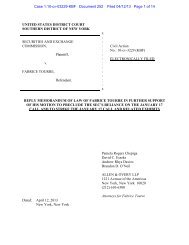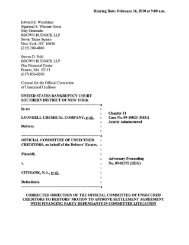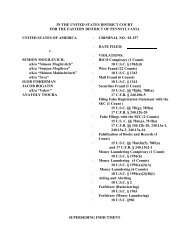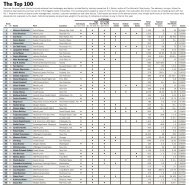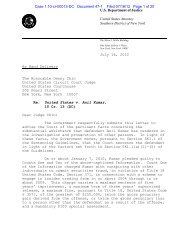Salz Review - Wall Street Journal
Salz Review - Wall Street Journal
Salz Review - Wall Street Journal
You also want an ePaper? Increase the reach of your titles
YUMPU automatically turns print PDFs into web optimized ePapers that Google loves.
<strong>Salz</strong> <strong>Review</strong><br />
An Independent <strong>Review</strong> of Barclays’ Business Practices<br />
184<br />
humans and created a distance between banker and customer and banker and<br />
regulator, giving a sense of independence from normal subjective interactions.<br />
Culturally, financial service organisations were led by those whose basic assumptions were<br />
founded on money as the goal; numbers as the answers, and technology as the<br />
intermediary. The implications of replacing people with technology, judgment with money,<br />
and leadership with those skilled only in money making went unrecognised. Understanding<br />
how technology and mathematical judgments impact the social context is a daunting task,<br />
but the alternative, as we have seen, is not an option. Currently there is a social-technical<br />
gap. 270<br />
The study identified that the behaviours that drove culture presented a paradox to leaders<br />
of financial services. On the one hand, they recognised and associated numerical<br />
competence, regulatory lenience and the pace of business transaction as positive underlying<br />
reasons for their success. On the other hand, they realised that these cultural norms may<br />
have played a far greater role in the crisis than they were able to comprehend. The role of<br />
leadership in understanding and engineering the systemic cultural forces was missing.<br />
Those who benefited the most probably still have the most to unlearn and relearn if change<br />
is to be achieved.<br />
Culture and Value Creation<br />
Organisation culture is often talked about as a soft concept. In financial services<br />
particularly, culture has not been on the radar as a profit driver. However, there is<br />
increasingly a body of research which indicates the impact of culture on profitability.<br />
Research by Heskett (2011) 271 indicates that ’culturally unremarkable; competitors suffer a<br />
20-30% drop in performance.<br />
Heskett’s research claims to establish cause-and-effect relationships that are crucial to<br />
shaping effective cultures, and demonstrates how to calculate culture's economic value<br />
through ‘Four Rs’: referrals, retention, returns to labour, and relationships. The ‘Four Rs’<br />
can be measured by combining the organisation’s employee engagement metrics, customer<br />
loyalty metrics and brand loyalty metrics. Companies who intentionally managed their<br />
cultures effectively outperformed similar companies that did not.<br />
Other researchers have similarly identified culture as a key contributor to corporate<br />
performance. In 2006, Sackman and Stiftung conducted a detailed analysis of the culture of<br />
six companies: The BMW Group, Deutsche Lufthansa, Grundfos, Henkel, Hilti and Novo<br />
Nordisk. They concluded that “the corporate culture that distinguishes each of them today<br />
has, on the one hand contributed to their success and, on the other hand, placed them in a<br />
strong position as they face challenges to come.” 272<br />
Culture has also been studied empirically as to its role in corporate failure. Joel Bankan’s<br />
The Corporation 273 is a meta-study of corporate failure. His basic hypothesis is that corporate<br />
270 Brian Whitworth, Socio-Technical Systems, 2006.<br />
271 James L. Heskett, The Culture Cycle, 2011.<br />
272 Sonya Sackman and Bertlesman Stiftung, Corporate Culture and Leadership Behaviour, 2006.<br />
273 Joel Bankan, The Corporation: The Pathological Pursuit of Profit and Power, 2005.




